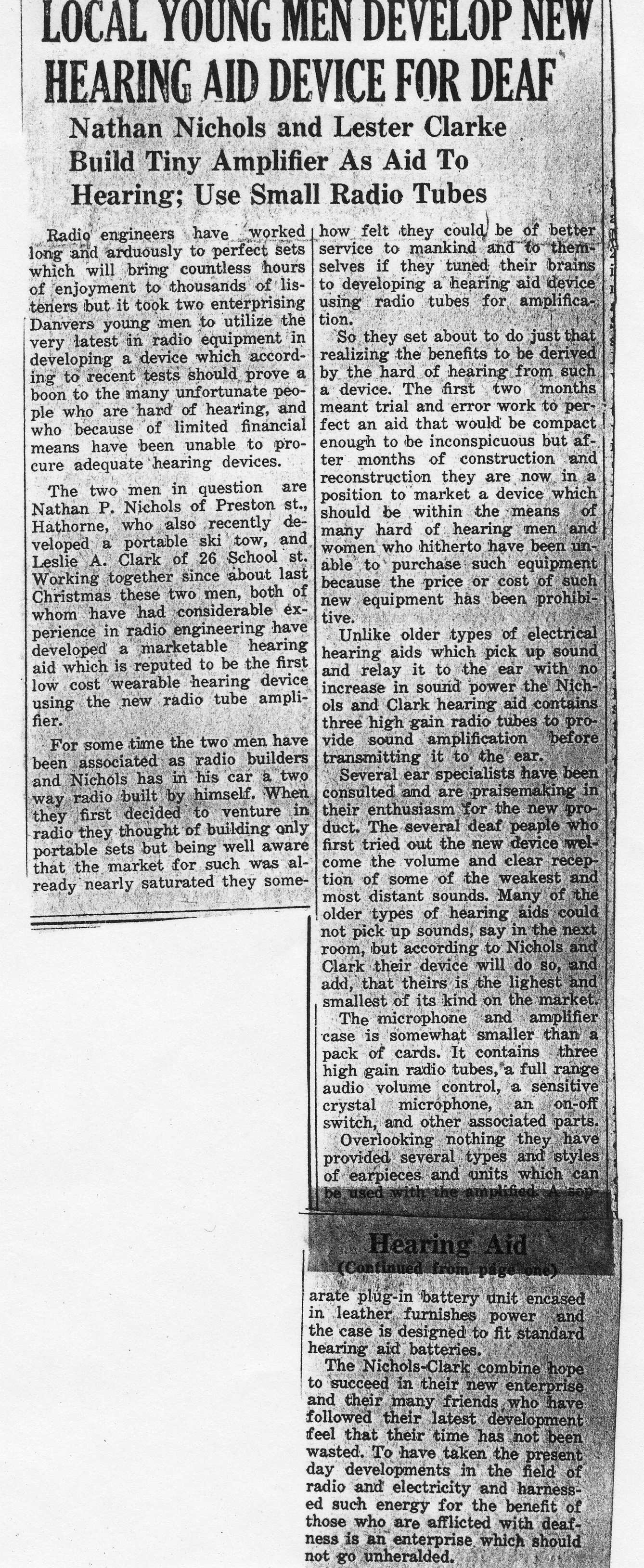LOCAL YOUNG MEN DEVELOP NEW HEARING AID DEVICE FOR DEAF
An undated newspaper article (probably from Danvers Herald) tells of Nathan Nichols and Lester (Leslie) Clark working together to create hearing aids. This was the beginning of Nichols & Clark, Inc. The date is probably 1939 or early 1940. My father's address is given as Preston St, which was his parents' home, so this is probably before his June 1940 marriage. I know his hearing aid work started in his bedroom in his parents' house, and then moved to the garage at the same address, 123 Preston (later renumbered/named as 124 Nichols St when Route 1 widening in 1950 blocked various streets). The garage no longer exists; an office park now covers that land; and the address has changed yet again, to 100 Conifer Hill Drive, Danvers.
[Scanned into computer, and converted to text, 1/31/2008 by Sandy Nichols Ward]

LOCAL YOUNG MEN DEVELOP NEW
HEARING AID DEVICE FOR DEAF
Nathan Nichols and Lester Clarke
Build Tiny Amplifier As Aid To
Hearing; Use Small Radio Tubes
The two men in question are Nathan P. Nichols of Preston st., Hathorne, who also recently developed a portable ski tow, and Leslie A. Clark of 26 School st. Working together since about last Christmas these two men, both of whom have had considerable experience in radio engineering have developed a marketable hearing aid which is reputed to be the first low cost wearable hearing device using the new radio tube amplifier.
For some time the two men have been associated as radio builders and is has in his car a two way radio built by himself. When they first decided to venture in radio they thought of building only portable sets but being well aware that the market for such was already nearly saturated they somehow felt they could be of better service to mankind and to themselves if they tuned their brains to developing a hearing aid device using radio tubes for amplification.
So they set about to do just that realizing the benefits to be derived by the hard of hearing from such a device. The first two months meant trial and error work to perfect an aid that would be compact enough to be inconspicuous but after months of construction and reconstruction they are now in a position to market a device which should be within the means of many hard of hearing men and women who hitherto have been unable to purchase such equipment because the price or cost of such new equipment has been prohibitive.
Unlike older types of electrical hearing aids which pick up sound and relay it to the ear with no increase in sound power the Nichols and Clark hearing aid contains three high gain radio tubes provide sound amplification before transmitting it to the ear.
Several ear specialists have been consulted and are praise-making in their enthusiasm for the new product. The several deaf people who first tried out the new device welcome the volume and clear reception of some of the weakest and most distant sounds. Many of the older types of hearing aids could not pick up sounds, say in the next room, but according to Nichols and Clark their device will do so, and add, that theirs is the lightest and smallest of its kind on the market
The microphone and amplifier case is somewhat smaller than a pack of cards. It contains three high gain radio tubes, a full range audio volume control, a sensitive crystal microphone, an on-off switch, and other associated parts.
Overlooking nothing they have provided several types and styles of earpieces and units which can be used with the amplifier. A separate plug-in battery unit encased in leather furnishes power and the case is designed to fit standard hearing aid batteries.
The Nichols-Clark combine hope to succeed in their new enterprise and their many friends who have followed their latest developments feel that their time has not been wasted. To have taken the present day developments in the radio and electricity and harnessed such energy for the benefit of those who are afflicted with deafness is an enterprise which should not go unheralded.